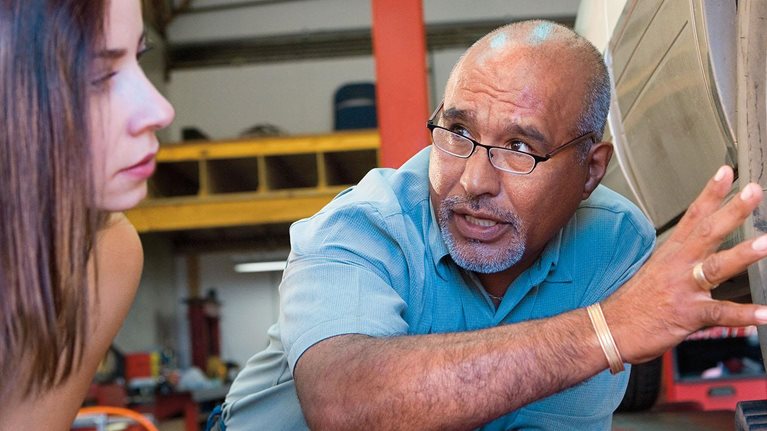In 2010, Brenda Wensil established one of the US government’s first-ever customer-experience roles. As the chief customer-experience officer of the US Department of Education’s Federal Student Aid (FSA) programs—the country’s largest single source of funding for postsecondary education—she has been integral to reshaping FSA’s strategy toward a more customer-centric view. Wensil recently sat down with McKinsey’s Kristin Allstadt and David Malfara to discuss her role and the importance of understanding culture and talent in implementing change within an organization where a strong focus on customers is critical to success.
McKinsey: Your role—chief customer-experience officer of FSA—was new to both FSA and US government agencies in general. What led to its creation?
Brenda Wensil: FSA has always had a conversation about students and parents—who they are and what information they need from us—but we never really had a cohesive customer-experience organization until 2011. In the aftermath of the 2008 financial crisis, the department found itself in a much more customer-facing role, with a higher degree of direct interaction with student borrowers. The chief operating officer at that time had come from private-sector financial services and was very familiar with the potential benefits of a more customer-centric focus, so that was the right time to create the office.
McKinsey: How does the Customer Experience Office fit in with the organization’s overall goals?
Brenda Wensil: FSA has broad accountability for dispersing funds for higher education and for the management of services, as well as compliance for aid-dispersal and security protocols. Our team has a specific focus on the application and repayment experience within the fund-dispersal process. Early on, I worked with the executive team to create a clear link between customer experience and the goals of the broader organization. We have metrics and targets using American Customer Satisfaction Index scores as our top-line measure of the customer experience. We also have goals to increase the number of total applications, to increase the number of applications from citizens with low to moderate incomes and first-generation citizens, and to reduce default rates through financial counseling for borrowers before they apply for a loan.
McKinsey: Where in the process did your team start to improve the customer experience, and how did you decide what your priorities should be?
Brenda Wensil: We started with the data analytics of customer information and created a segmentation to give us insights. We launched a social-media strategy because our customers—for example, college-age citizens—are the largest users of social media, so that is a valuable channel and source of information. Our presence on Twitter, YouTube, and Facebook has grown exponentially over the last few years.
Stay current on your favorite topics
We launched an organization-wide customer-listening process on social media and consolidated a half-dozen websites into Studentaid.gov, which is the flagship site for FSA. Using some simple text analytics—themes that came to the forefront were “repayment” and “application”—we began to learn a lot about what really mattered to our customers. So we started digging deeper into those areas and identifying places where we could make some improvements.
McKinsey: If your priority customer journeys were application and repayment, what are some of the ways you’ve worked to improve those experiences for students?
Brenda Wensil: Simplification has been our rallying cry. We know that if we make the process simpler for our applicants, we will achieve our organizational goals for the number and mix of applicants and default rates. One of the biggest efforts we have taken on, which we rolled out in October 2016, was to change the timing of the Free Application for Student Aid registration.
For decades, the January 1st start date for registration was not aligned with the tax-reporting cycle for the previous year’s income or with the time when students actually apply to college, which typically is in the fall. Moving the registration date makes the process simpler for our customers because they can now use tax reports from the prior year, and the financial-aid process will align more closely with the college admissions and application cycle. The change also has several other benefits for our customers, including the ability to receive and review financial-aid information sooner, as well as the potential for an additional three months of lead time to apply for state and institutional financial aid.
We’ve also made some progress improving repayment and reducing default through email marketing campaigns. We worked with our behavioral-insights team to create and test multiple email campaigns targeting several different segments of our borrowers. This started off small, but over the last three years we’ve gained significant insights about what does and doesn’t work on default prevention. The communication process is now an operational part of the repayment process.
McKinsey: What have been some of the critical success factors for making progress on your priority initiatives?
Brenda Wensil: Creating the role of the chief customer-experience officer within FSA was a significant step. By design, the role had direct accountability over the front-end process from applications to central processing, so we could set the priorities and move faster. Also, since this role was part of the organization’s operating committee, I had involvement in the process for prioritizing spending and setting strategy.
Beyond that, I found it really important to work within the organization to build support for customer-experience initiatives and to create a strong culture of collaboration and excellence within the team. In part, data-driven strategies helped get some smaller efforts off the ground, but we also tried to integrate customer-focused work into larger initiatives that were already funded and under way. In this way, we could remain relatively cost neutral and test things like the default-prevention email campaigns. These have now been running for three years. They have been successful, gained momentum, and are an operational part of the repayment-communication process. In short, I think the most important thing is to know the culture of your organization and figure out the best ways to drive the change you want within that structure. Change the culture where you can, and work within it where you can’t.
McKinsey: What are you working on for the future of the customer experience at FSA?
Brenda Wensil: Right now, we are working on mapping the entire process across our two major customer journeys—application and repayment—to identify opportunities to simplify and streamline the digital experience. We are trying to identify which communications work and which don’t within certain subsegments of the borrowing population. We are also looking at certain products, like the Parent PLUS loan, and realizing that we could significantly redesign the total number of steps in the process. Again, we are focusing on making things as simple as possible for students applying for aid and the millions of borrowers in repayment.

The CEO guide to customer experience
We’ve also started looking into ways to rethink many of our processes by using digital or mobile technology, taking a cue from some of the more successful private-sector financial-services firms. We are starting to pull together agile teams, where possible, to think about how the customer journey—all the way from application to repayment—could be streamlined to make it as simple and as frictionless as possible. Finally, we have several ongoing efforts to educate our customers so that the borrowing base has a full understanding of the process before applying. We want to make sure that there are never any surprises.
McKinsey: What advice would you offer others within the public sector who are taking on a similar transformation toward a more customer-centric approach?
Brenda Wensil: One big lesson was to focus early on getting the right talent into the customer-experience organization. I started with a chief of staff, a director of customer data and analytics, and a marketing and outreach director, all of whom have been critical to our success.
I would also reiterate how important it is to understand and work within your organization’s structure and culture, which can be the most challenging aspect of the work at times. It’s difficult to drive progress on the customer experience without support across functions, so it’s important to understand the pain points within the organization and to show some early wins and progress to gain the support necessary. Getting some momentum gives you the right to tackle much bigger things. Stick with it. This work is iterative and doesn’t happen overnight.


